“Fiction invites us into the imaginary world the author has created; nonfiction intrudes into our world, and purports to tell us something about it.”
After reading the first Notice and Note book by Kylene Beers and Bob Probst, I knew I had to read the nonfiction book. Just like with the first book, I got through this one in about 3-4 days. The authors have a way of writing that makes it easy to get through and makes you not want to put the book down.
The first section of this book is all about defining nonfiction (they really make you think twice about your own definition of nonfiction, what you were taught as a kid, and what you may/may not teach your kids now). Once they have defined nonfiction for all stages of learning, they again discuss rigor and complexity just like they did with fiction texts. The thing that stuck with me the most with rigor and complexity in the first book, was again mentioned in this book... reading a difficult text is not rigor, how a student is engaged with a text increases rigor.
Since this book is focusing on nonfiction, Beers and Probst include a section about disciplinary literacy. They do a great job of including how these strategies, signposts, etc. can be used across all content areas (math, science, social studies). For someone like myself that teaches all subjects, I loved this because it will allow the students to see that they can use these strategies, etc. in all areas, not just reading class.
The next section of this book focuses on 3 "Big Questions" that students can be asking themselves as they read any and all nonfiction text.
- What surprised me? (replaces "what did you learn?")
- What did the author think I already knew? (students ask this when confused)
- What challenged, changed, or confirmed what I already knew? (teaches children that it is ok to change your mind)
The next section of the book focuses on the signposts. There are five signposts for nonfiction text.
- Contrasts and Contradictions
- Extreme or Absolute Language
- Numbers and Stats
- Quoted Words
- Word Gaps
I love these signposts because they should be easy to spot for the kids when reading nonfiction, but the questions that go along with them help the students to slow down and really think about what the author is saying in the text.
The last section of this book focuses on strategies that the teacher/students can use before, during, and after reading. These strategies are tools that the teachers and students can use to scaffold our thinking process.
As with the first Notice and Note book, I loved this book and can't wait to use it in my classroom. Our unit for quarter 2 is all about nonfiction, so stay tuned come November for examples of ways I am using it in my room!

No comments:
Post a Comment